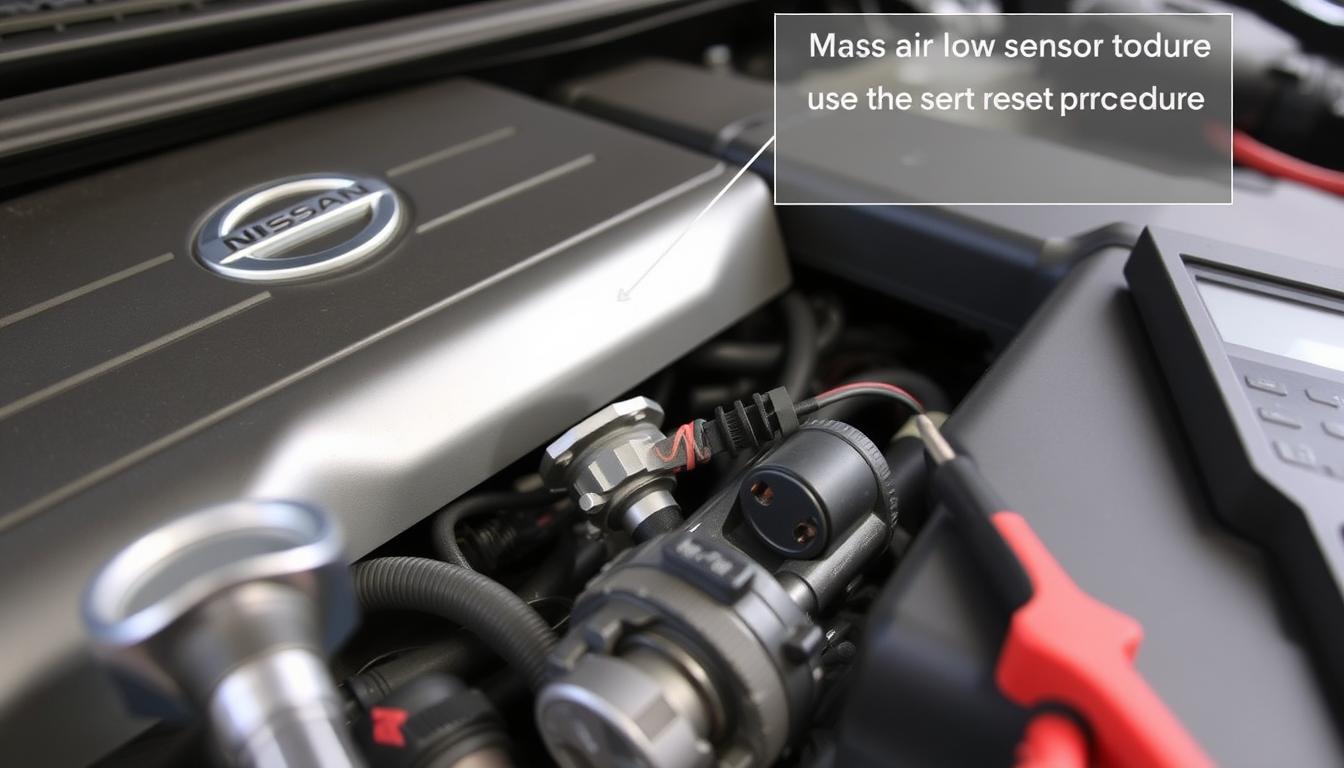Learning to reset the mass air flow sensor in your Nissan Altima is key for your car’s best performance. The mass air flow (MAF) sensor measures air intake for the engine. Resetting it can fix problems like a rough idle, lower fuel economy, and stuttering when you accelerate. Resetting the MAF sensor is easy, whether you’ve cleaned or replaced it. This guide will show you how to do it, including the benefits and what might happen if you don’t do it right.
Knowing why you need to reset your MAF sensor is important for your car’s health. By following this guide, you can reset your MAF sensor and make your car run smoothly again. If you’re having trouble with your MAF sensor or just want to know how to reset it, this guide is for you.
Key Takeaways
- Resetting the MAF sensor can help resolve issues such as rough idle and reduced fuel economy
- A Nissan Altima MAF sensor reset is relatively simple to do and can be done at home
- Resetting the MAF sensor is necessary after cleaning or replacing the sensor
- Not resetting the MAF sensor properly can lead to potential damage to the engine
- The process of resetting the MAF sensor typically takes around 12 to 15 minutes
- It’s recommended to clean or replace the MAF sensor if it’s faulty, with a cost ranging from $120 to $300
Understanding Mass Air Flow Sensors in Nissan Altimas
The mass air flow (MAF) sensor is key to your Nissan Altima’s engine. It measures air intake, ensuring the engine gets the right mix of air and fuel for best performance.
What is a Mass Air Flow Sensor?
A MAF sensor is an electronic device between the air filter and the engine. It sends data to the car’s computer about air intake. This helps control fuel injection and ignition timing.
How MAF Sensors Affect Engine Performance
A working MAF sensor is vital for engine performance. It impacts fuel economy, power, and emissions by keeping the fuel-air mix balanced.
Common Signs of MAF Sensor Issues
MAF sensor problems can cause several issues:
- Engine misfires or rough idling
- Decreased fuel efficiency
- Increased emissions
- Check engine light activation
Regular Nissan Altima mass airflow sensor troubleshooting can spot these problems early. This helps avoid engine damage and keeps your vehicle running well.
Why You Need to Reset Your MAF Sensor
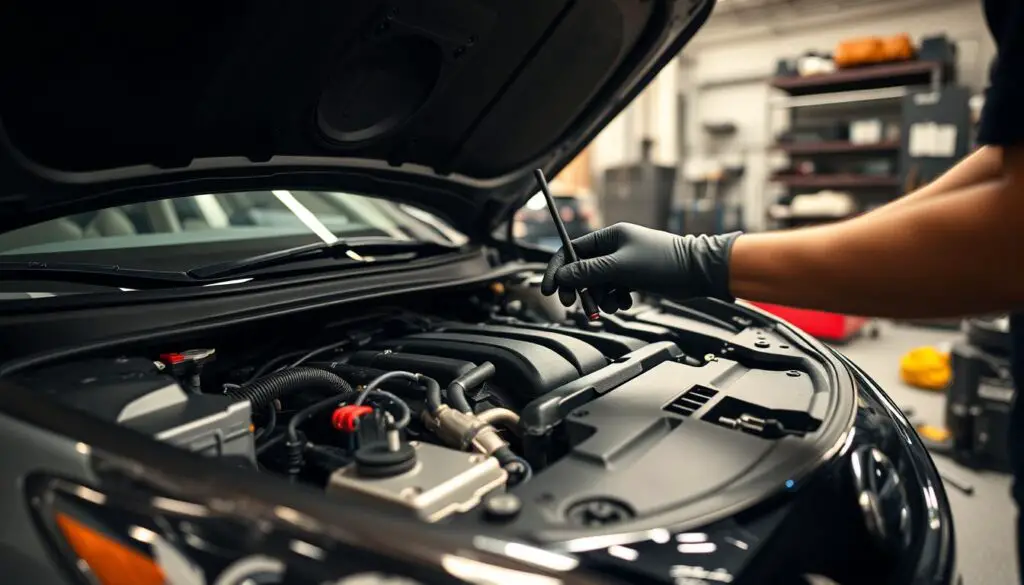
Resetting the MAF sensor is key for your Nissan Altima’s smooth operation. Cleaning or replacing the sensor requires a reset to ensure the engine control module (ECM) recalibrates. This adjustment is crucial for maintaining the perfect air and fuel mix, improving engine performance.
Resetting the MAF sensor lets the ECM adjust to any maintenance changes. This action fixes issues like rough idling, lower fuel efficiency, and odd engine behavior. Without a reset, the ECM might rely on old data, causing poor performance.
Resetting the MAF sensor is advised in several situations. After cleaning with mass air flow sensor cleaning spray, a reset prevents any leftover residue from affecting sensor readings. Also, installing a new MAF sensor requires a reset to let the ECM smoothly integrate it into the vehicle’s system.
Resetting the MAF sensor also clears error codes like P0102, which may pop up after maintenance. This action keeps the check engine light off and ensures your Altima runs well. By following the Nissan Altima MAF sensor reset steps, you boost your vehicle’s dependability and lifespan.
Essential Tools and Materials Required
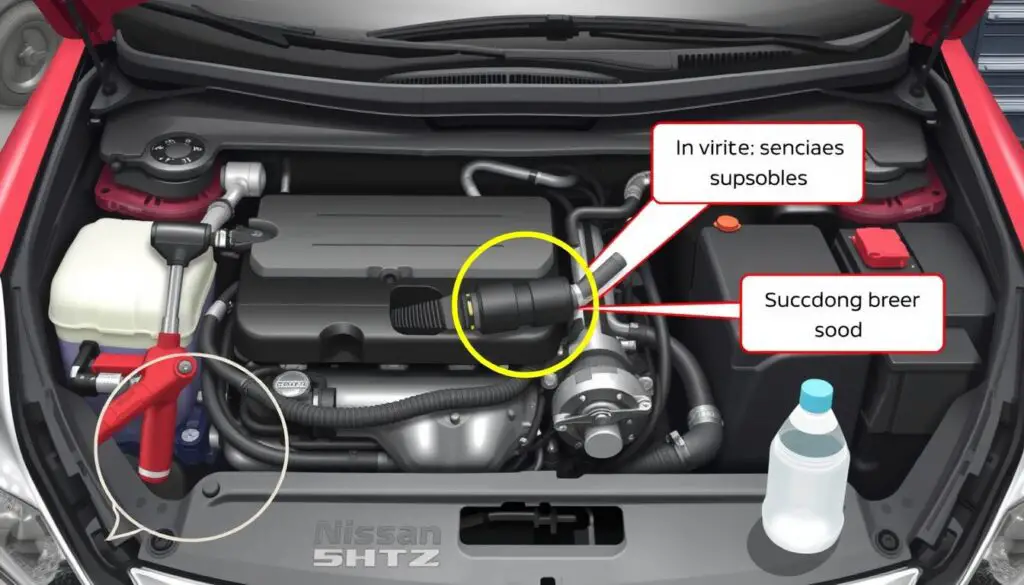
Getting the right tools is key for your Nissan Altima mass air flow sensor reset. Having everything ready makes the process easier and faster.
Required Tools List
- Screwdriver: Essential for removing the MAF sensor screws.
- Socket Set: Useful for accessing hard-to-reach areas.
- Multimeter: Helps in diagnosing sensor performance.
Optional Equipment
- Torque Wrench: Ensures screws are tightened to the manufacturer’s specifications.
- MAF Sensor Cleaner: Assists in maintaining sensor cleanliness.
- Magnetic Tray: Keeps screws and small parts organized during the reset.
Safety Equipment Needed
- Safety Gloves: Protects your hands from debris and sharp edges.
- Safety Glasses: Shields your eyes while working under the hood.
- Protective Clothing: Prevents stains and injuries from tools.
| Tool | Quantity | Purpose |
|---|---|---|
| Screwdriver | 1 | Removing MAF sensor screws |
| Socket Set | 1 | Accessing tight areas |
| Multimeter | 1 | Diagnosing sensor issues |
| Torque Wrench | 1 | Ensuring proper screw tightness |
| MAF Sensor Cleaner | 1 | Cleaning the sensor |
| Magnetic Tray | 1 | Organizing screws and parts |
| Safety Gloves | 1 pair | Protecting hands |
| Safety Glasses | 1 pair | Protecting eyes |
| Protective Clothing | 1 set | Preventing injuries |
Safety Precautions Before Starting
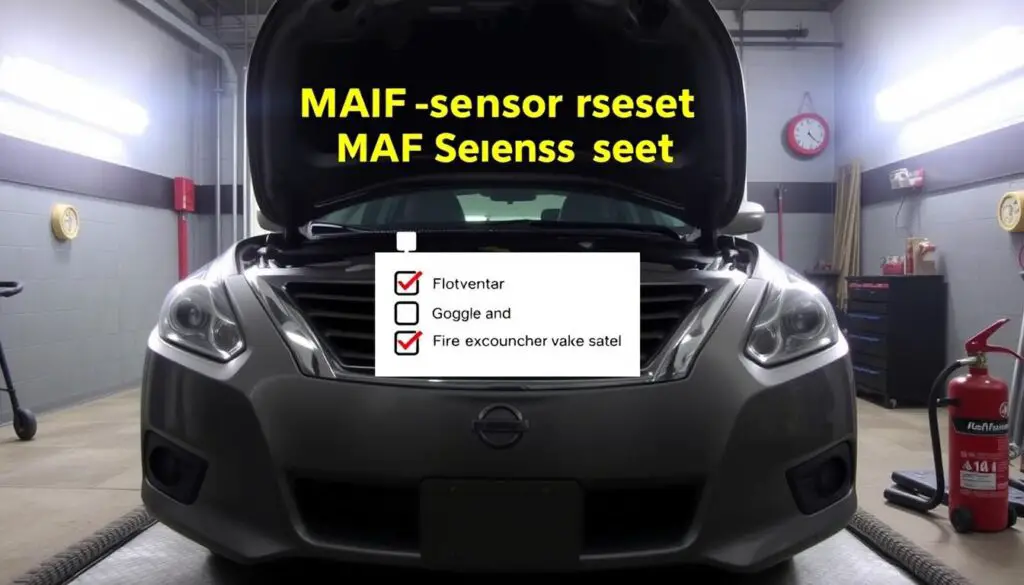
Before starting the Nissan Altima MAF sensor reset, it’s key to take safety steps. These steps protect you and your car. They help avoid injuries and damage during the reset.
- Ensure the Engine is Cool: Always make sure the engine has completely cooled down to avoid burns or other heat-related injuries.
- Disconnect the Battery: Disconnecting the car battery for 10 to 15 minutes is crucial. This allows the ECU to reset and update parameters, ensuring a smooth reset of the mass air flow sensor Nissan Altima.
- Work in a Well-Ventilated Area: Perform the reset in a space with good ventilation to avoid inhaling any harmful fumes that may arise during the process.
- Avoid Touching the Sensing Element: The MAF sensor’s internal components are delicate. Refrain from touching them to prevent malfunctions.
- Use Proper Tools: Utilize the correct tools to avoid damaging the sensor or other parts of your vehicle during the reset.
Up to 80% of mass air flow sensor failures are caused by dirt or grease accumulation. Regularly maintaining and replacing the air filter can help prevent impurities from entering the engine and affecting the MAF sensor. Also, improper installation is a common reason for vehicle malfunctions after replacing the MAF sensor. Following these safety precautions ensures a successful reset and extends the longevity of your Nissan Altima’s engine components.
| Safety Precaution | Description |
|---|---|
| Ensure Engine is Cool | Prevents burns and accidents caused by hot engine parts. |
| Disconnect the Battery | Allows ECU to reset, ensuring accurate sensor calibration. |
| Work in a Well-Ventilated Area | Avoids inhaling harmful fumes during the reset process. |
| Avoid Touching Sensing Element | Prevents damage to the delicate parts of the MAF sensor. |
| Use Proper Tools | Reduces the risk of damaging vehicle components during the reset. |
Locating the Mass Air Flow Sensor on Your Nissan Altima
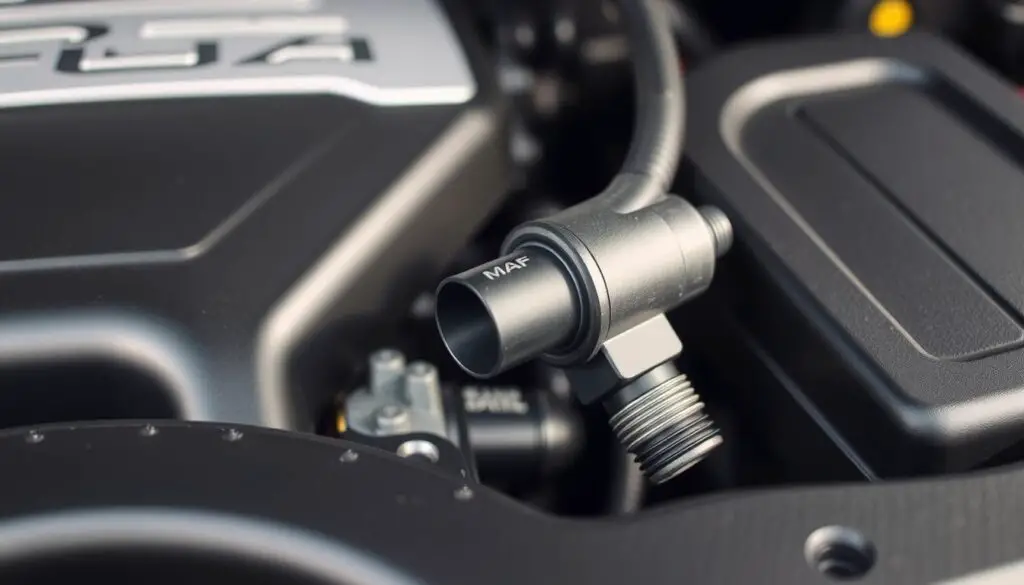
Finding the Mass Air Flow (MAF) sensor is key before you reset it. It’s usually between the air filter and the engine manifold. But, its exact spot can change with the model year.
Different Model Year Locations
In older Nissan Altima models, the MAF sensor is near the top of the engine bay. It’s connected to the air intake tube. For newer models, it’s closer to the engine block, on the intake manifold. Here’s a quick guide:
| Model Year | MAF Sensor Location |
|---|---|
| 2010-2012 | Top of the engine bay, near the air filter housing |
| 2013-2018 | Closer to the engine block, mounted on the intake manifold |
| 2019-Present | Integrated into the air intake system, near the throttle body |
Visual Identification Guide
The MAF sensor is a small, rectangular device. It has an electrical connector and a wiring harness. Look for a component with a flat or slightly curved sensor element in a plastic casing. Here’s what it looks like:
Make sure you can spot the sensor before you reset it. Knowing what it looks like helps avoid confusion with other parts.
How to Reset Mass Air Flow Sensor Nissan Altima
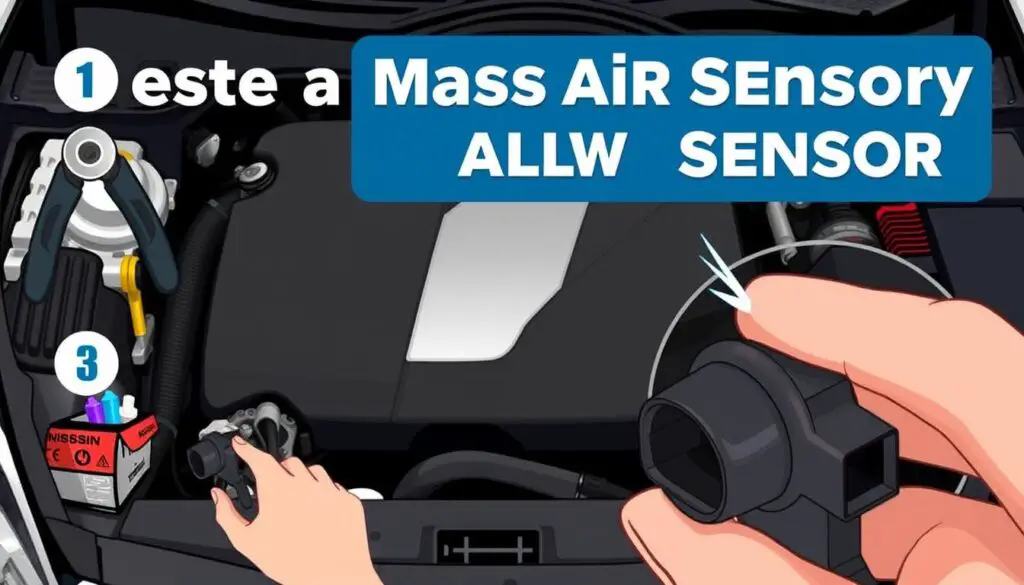
Resetting the mass air flow sensor in your Nissan Altima can boost engine performance and fuel efficiency. This guide will help you reset it safely.
- Disconnect the Battery:
- Turn off your vehicle and open the hood.
- Find the negative battery terminal and loosen it with a wrench.
- Take off the terminal and wait for 10 minutes to let the ECU reset.
- Put the battery terminal back on securely.
- Idle the Engine Without the Sensor:
- With the engine off, take out the mass air flow sensor.
- Start the engine and let it idle for 10 seconds.
- Turn off the engine and put the MAF sensor back.
- Start the vehicle to check if the reset worked.
After using either method, your Nissan Altima should know the reset is done. If the check engine light stays on or problems continue, get help from a pro.
| Method | Steps | Time Required | Notes |
|---|---|---|---|
| Disconnecting the Battery | Remove negative terminal, wait, reconnect. | 10 minutes | Ensures ECU resets completely. |
| Idling Without Sensor | Remove MAF sensor, idle engine, reinstall. | 10 seconds | Quick reset method. |
Disconnecting the Battery Properly
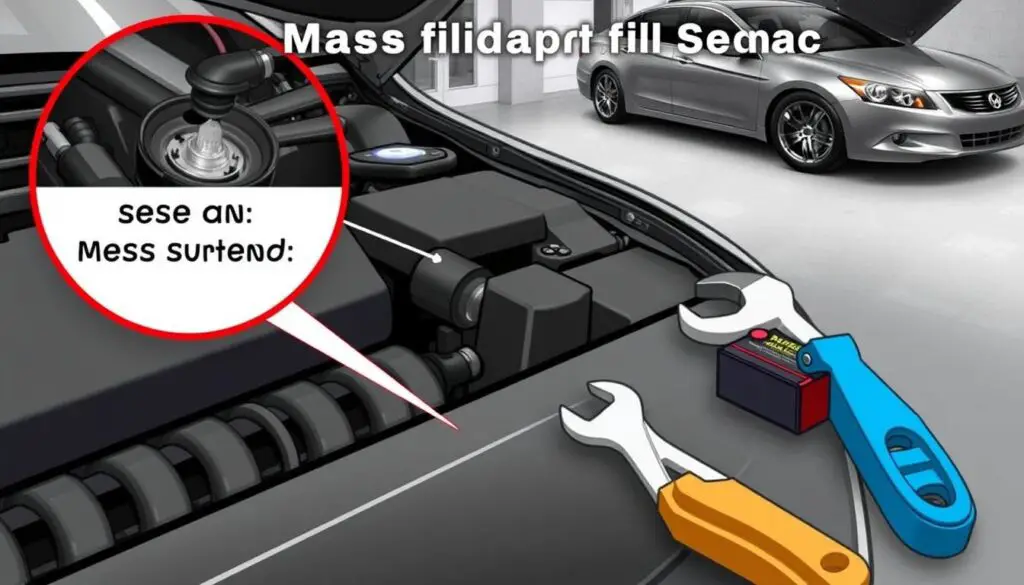
Resetting your Nissan Altima’s MAF sensor starts with safely disconnecting the battery. This step is key to ensure the reset works right.
Battery Terminal Removal Steps
- Park your Nissan Altima on a flat surface and turn off the engine.
- Locate the battery under the hood.
- Using a wrench, loosen the nut on the negative (-) terminal.
- Carefully remove the negative terminal and secure it away from the battery.
- Repeat the process for the positive (+) terminal if necessary.
Waiting Period Guidelines
After removing the battery terminals, wait to let the vehicle’s electronics reset. This is part of the Nissan Altima mass air flow sensor reset instructions.
| Action | Time | Purpose |
|---|---|---|
| Disconnect Negative Terminal | 5 minutes | Initial power cut |
| Wait Period | 10 minutes | Ensure complete reset of the ECU |
Removing the MAF Sensor
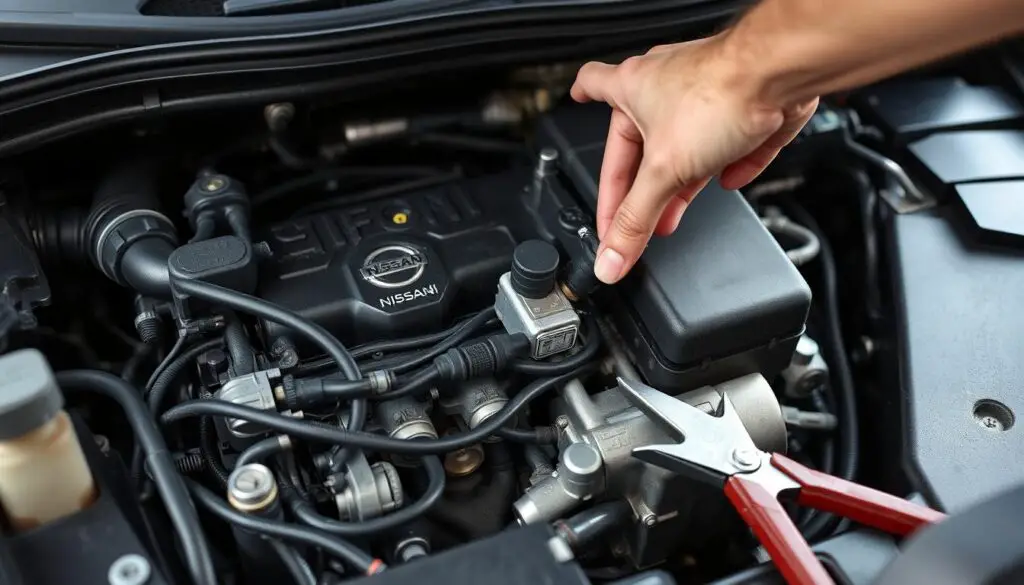
Removing the MAF sensor is a key step in the Nissan Altima MAF sensor reset tutorial. Follow these steps for a safe and effective removal.
- Start by finding the MAF sensor, usually near the air filter housing.
- Use a screwdriver to remove the sensor’s mounting screws carefully.
- Disconnect the wiring harness by pressing the release tab and gently pulling it away.
- Be careful with the sensor to avoid damaging its delicate parts.
- Take the MAF sensor out of its housing and put it aside for cleaning or replacement.
After removing it, check the sensor and the area around it for wear or damage. Proper handling during this step helps avoid problems during the reset.
| Tool | Purpose |
|---|---|
| Screwdriver | To unfasten mounting screws |
| Gloves | To protect hands and sensor |
| Clean Cloth | To wipe down the sensor if cleaning |
Cleaning vs. Resetting: What’s the Difference
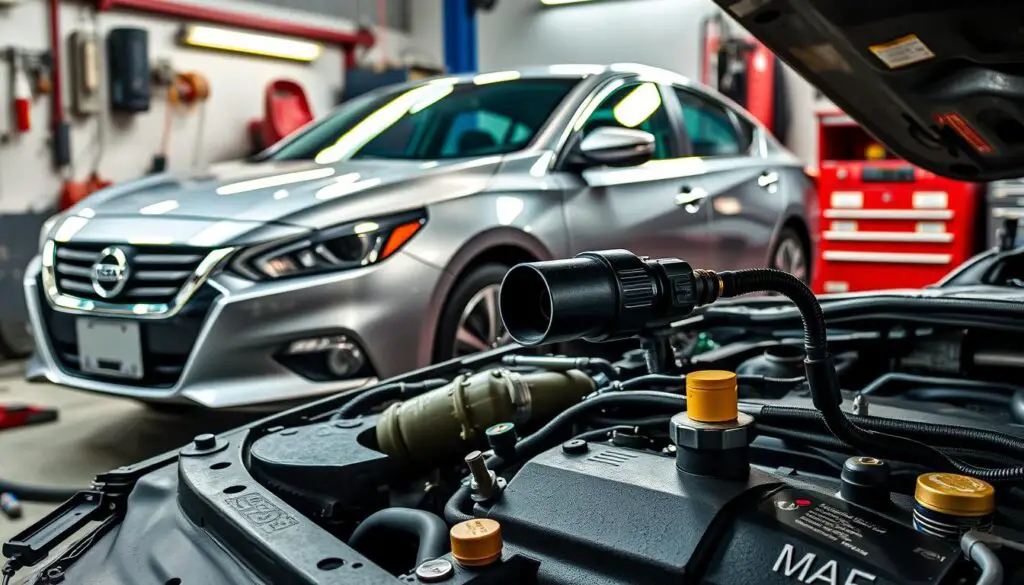
Keeping your Nissan Altima’s Mass Air Flow (MAF) sensor in top shape is key for your engine’s health. Knowing when to clean or reset the sensor can save you time and avoid costly fixes.
When to Clean
If your car stutters when you accelerate or uses more fuel than usual, it’s time to clean the MAF sensor. Dirt and deposits can mess with its accuracy. Many find that a good cleaning can fix the problem without needing a full reset.
When to Reset
Reset the MAF sensor if cleaning doesn’t turn off the Malfunction Engine Light. If problems linger after cleaning, a reset can help the sensor get back on track. Nissan Altima MAF sensor reset tips suggest this process takes about 12 to 15 minutes.
Professional Recommendations
Experts say to figure out the real cause before deciding to clean or reset. Sometimes, a cracked PVC pipe can set off MAF sensor alerts. They recommend checking air filters and for air leaks before doing a full reset.
| Aspect | Cleaning | Resetting |
|---|---|---|
| When to Use | Minor performance issues, dirt buildup | Persistent engine light, calibration needs |
| Time Required | 10-15 minutes | 12-15 minutes |
| Common Symptoms Addressed | Stuttering, rough idle | Malfunction Engine Light, error codes |
| Professional Advice | Check for air leaks before cleaning | Diagnose root causes beyond the MAF sensor |
Proper MAF Sensor Maintenance Tips
Keeping your Nissan Altima’s MAF sensor in top shape is key for great engine performance. Regular care helps avoid problems and makes the sensor last longer.
- Regular Cleaning: Use a recommended MAF sensor cleaner like CRC to gently remove dirt and debris.
- Inspect Air Ducts: Make sure air ducts are free from cracks or blockages that can disrupt airflow.
- Check Electrical Connections: Secure all connections to prevent faulty readings during a Nissan Altima MAF sensor reset.
- Replace Air Filters: A clean air filter supports proper airflow, reducing strain on the mass airflow sensor reset procedure.
- Monitor Engine Performance: Keep an eye on fuel efficiency and engine behavior to detect early signs of MAF sensor issues.
Proactive maintenance not only minimizes the need for frequent Nissan Altima mass airflow sensor reset procedures but also ensures smoother engine operation.
Always follow the manufacturer’s guidelines for maintenance intervals. By following these tips, you can greatly reduce the risk of errors like DTC P0101. This ensures your Nissan Altima runs efficiently.
| Maintenance Task | Frequency | Details |
|---|---|---|
| Clean MAF Sensor | Every 20,000 miles | Use MAF cleaner to remove buildup |
| Inspect Air Ducts | Every 15,000 miles | Look for cracks or blockages |
| Replace Air Filter | Every 12,000 miles | Ensure proper airflow |
| Check Electrical Connections | Every 10,000 miles | Secure all MAF sensor connectors |
| Monitor Engine Performance | Ongoing | Watch for signs of poor performance |
Common Reset Problems and Solutions
Resetting the mass air flow sensor in your Nissan Altima can sometimes lead to unexpected challenges. Understanding these issues can help you address them effectively.
Troubleshooting Guide
If you encounter problems after resetting the MAF sensor, consider the following steps:
- Engine Light Remains On: This might indicate that the reset was unsuccessful or another issue exists.
- Stuttering Acceleration: The engine may not be receiving the correct air-fuel mixture.
- Rough Idle: An uneven idle could suggest sensor misalignment or contamination.
- Reduced Fuel Economy: Inefficient fuel usage might be caused by incorrect sensor readings.
Error Code Meanings
Error codes provide valuable insights into specific issues. For example, P0113 indicates a problem with the MAF sensor circuit, often due to an incorrect sensor type installed. Addressing these codes promptly can prevent further engine damage.
Following the Nissan Altima MAF sensor reset steps carefully ensures a smoother troubleshooting process. If issues persist after attempting these solutions, seeking professional assistance is advisable to avoid costly repairs.
When to Seek Professional Help
Many Nissan Altima owners can do basic maintenance themselves. But, sometimes a Nissan Altima mass air flow sensor reset guide isn’t enough. If engine problems keep happening after you try to reset it yourself, it’s time to get help from a pro.
Here are some times when you should get expert help:
- Keep seeing error codes like P0019, P2298, or P0765 even after resetting the MAF sensor.
- Your car has over 115,000 miles, making sensor problems harder to fix.
- Fuel trim issues keep messing with the air-fuel ratio.
- You’re not sure how to do the reset steps right.
Finding a good mechanic is key. Look for someone like Marvin Sunderland, with over 23 years of experience. Your Mechanic offers:
- Certified mechanics who come to you for your convenience.
- A 12-month, 12,000-mile guarantee for your peace of mind.
- Fair and clear pricing with no hidden fees.
Experts can find problems a simple reset might miss. They use advanced tools to check your Nissan Altima MAF sensor reset tutorial. This ensures your car runs well for a long time.
| Service | Benefits |
|---|---|
| Certified Mechanics | Experienced and trained to handle complex issues |
| Mobile Service | Convenient, saves time and hassle |
| Warranty | Protection and assurance on services provided |
Post-Reset System Check
After resetting your Nissan Altima’s mass air flow sensor, it’s key to check if it worked. This step makes sure your car runs well and efficiently.
Verifying Proper Operation
Start your Nissan Altima and let it idle. Listen for any odd noises and watch the dashboard for warning lights. A good reset means a steady idle and no check engine lights. Also, check if the engine accelerates smoothly and performs consistently.
Test Drive Guidelines
Take your car for a short drive to confirm the reset. Notice how it accelerates, handles, and responds to the throttle. A correct reset should fix issues like stuttering, rough idle, and poor fuel efficiency. If problems persist, you might need to reset again or get professional help.
| Check | What to Look For |
|---|---|
| Engine Idle | Smooth and consistent without hesitation |
| Dashboard Lights | No warning or check engine lights active |
| Acceleration | Responsive and free from stuttering or lag |
| Fuel Efficiency | Improved or stable fuel consumption rates |
Preventing Future MAF Sensor Issues
Keeping your Nissan Altima’s mass airflow sensor in good shape is key for your engine’s performance. Regular care can prevent common problems and keep your car running well.
Maintenance Schedule
Make a plan for regular maintenance to keep the MAF sensor working well. Here’s what you should do:
- Check the MAF sensor every 20,000 miles.
- Change or clean the air filter every six months to stop debris from blocking airflow.
- Look for vacuum leaks during oil changes to get accurate sensor readings.
Best Practices
Here are some tips to make your MAF sensor last longer:
- Drive Smoothly: Don’t speed up quickly or brake hard to protect your engine.
- Regular Cleaning: Use the right MAF sensor cleaners during maintenance to remove dirt.
- Secure Connections: Make sure all electrical connections to the MAF sensor are tight and corrosion-free.
- Avoid Aftermarket Modifications: Use only parts recommended by the manufacturer to keep sensor accuracy.
By following these tips and sticking to a regular maintenance schedule, you can avoid future MAF sensor problems. This will make your vehicle more reliable.
Cost Comparison: DIY vs. Professional Service
Choosing to reset your Nissan Altima MAF sensor yourself or getting a pro to do it is a big decision. Doing it yourself can cost between $20 and $100. This depends on the tools and parts you need, like cleaning solutions and air filters.
Getting a professional to reset your Nissan Altima mass air flow sensor can cost between $120 and $300. This price includes their labor and the knowledge to do it right. It also lowers the chance of more problems.
- DIY Reset: Lower cost, flexibility in timing, but requires some mechanical knowledge.
- Professional Service: Higher cost, assurance of proper execution, and often includes warranties.
| Service Type | Cost Range | Pros | Cons |
|---|---|---|---|
| DIY Reset | $20 – $100 | Affordable, immediate action, learning experience | Requires tools and knowledge, potential for mistakes |
| Professional Service | $120 – $300 | Expertise, guaranteed setup, time-saving | More expensive, scheduling needed |
It all comes down to your budget and how comfortable you are with car care. If you’re sure you can follow a Nissan Altima mass air flow sensor reset guide, DIY might be the way to go. But if you want the peace of mind that comes with a pro’s touch, it’s worth the extra cost.
Conclusion
Resetting the mass air flow sensor in your Nissan Altima is easy and important. This guide has shown you how to do it step by step. It’s designed to make the process simple.
Keeping the MAF sensor in good shape helps your engine run better. This means better fuel economy and fewer engine problems. Learning how to reset the sensor helps you take care of your car better.
By following this guide, you can keep your Altima’s MAF sensor working well. This ensures your car runs smoothly and lasts longer. Stay informed and take care of your car to enjoy a better driving experience.
FAQ
How do I reset the mass air flow sensor on my Nissan Altima?
What tools are required for a Nissan Altima MAF sensor reset?
When should I consider resetting the MAF sensor on my Nissan Altima?
What are common signs that my Nissan Altima’s MAF sensor needs resetting?
Can I reset the MAF sensor on a Nissan Altima without disconnecting the battery?
What is the difference between cleaning and resetting the MAF sensor on a Nissan Altima?
How can I troubleshoot issues after resetting the MAF sensor on my Nissan Altima?
Is it better to reset the MAF sensor myself or seek professional service for my Nissan Altima?
How often should I perform maintenance on the MAF sensor of my Nissan Altima?
What are the potential costs of resetting the MAF sensor myself versus hiring a professional?
How can I verify that the MAF sensor reset was successful on my Nissan Altima?

Jack Thompson is a writer and seasoned auto mechanic with over 15 years of experience in the automotive industry. Known for his expertise in vehicle mechanics, Jack has a deep understanding of car and truck systems. His skills, honed through years of hands-on experience, have made him a trusted name in the field. Jack is committed to providing valuable insights into car maintenance and repair, helping vehicle owners keep their vehicles in top condition.

